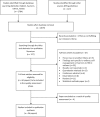Barriers and facilitators of effective self-management in asthma: systematic review and thematic synthesis of patient and healthcare professional views
- PMID: 28993623
- PMCID: PMC5634481
- DOI: 10.1038/s41533-017-0056-4
Barriers and facilitators of effective self-management in asthma: systematic review and thematic synthesis of patient and healthcare professional views
Abstract
Self-management is an established, effective approach to controlling asthma, recommended in guidelines. However, promotion, uptake and use among patients and health-care professionals remain low. Many barriers and facilitators to effective self-management have been reported, and views and beliefs of patients and health care professionals have been explored in qualitative studies. We conducted a systematic review and thematic synthesis of qualitative research into self-management in patients, carers and health care professionals regarding self-management of asthma, to identify perceived barriers and facilitators associated with reduced effectiveness of asthma self-management interventions. Electronic databases and guidelines were searched systematically for qualitative literature that explored factors relevant to facilitators and barriers to uptake, adherence, or outcomes of self-management in patients with asthma. Thematic synthesis of the 56 included studies identified 11 themes: (1) partnership between patient and health care professional; (2) issues around medication; (3) education about asthma and its management; (4) health beliefs; (5) self-management interventions; (6) co-morbidities (7) mood disorders and anxiety; (8) social support; (9) non-pharmacological methods; (10) access to healthcare; (11) professional factors. From this, perceived barriers and facilitators were identified at the level of individuals with asthma (and carers), and health-care professionals. Future work addressing the concerns and beliefs of adults, adolescents and children (and carers) with asthma, effective communication and partnership, tailored support and education (including for ethnic minorities and at risk groups), and telehealthcare may improve how self-management is recommended by professionals and used by patients. Ultimately, this may achieve better outcomes for people with asthma.
Conflict of interest statement
The authors declare that they have no competing financial interests.
Figures
Similar articles
-
Exercise interventions and patient beliefs for people with hip, knee or hip and knee osteoarthritis: a mixed methods review.Cochrane Database Syst Rev. 2018 Apr 17;4(4):CD010842. doi: 10.1002/14651858.CD010842.pub2. Cochrane Database Syst Rev. 2018. PMID: 29664187 Free PMC article.
-
Factors that influence parents' and informal caregivers' views and practices regarding routine childhood vaccination: a qualitative evidence synthesis.Cochrane Database Syst Rev. 2021 Oct 27;10(10):CD013265. doi: 10.1002/14651858.CD013265.pub2. Cochrane Database Syst Rev. 2021. PMID: 34706066 Free PMC article.
-
Interventions for interpersonal communication about end of life care between health practitioners and affected people.Cochrane Database Syst Rev. 2022 Jul 8;7(7):CD013116. doi: 10.1002/14651858.CD013116.pub2. Cochrane Database Syst Rev. 2022. PMID: 35802350 Free PMC article.
-
Shared decision-making interventions for people with mental health conditions.Cochrane Database Syst Rev. 2022 Nov 11;11(11):CD007297. doi: 10.1002/14651858.CD007297.pub3. Cochrane Database Syst Rev. 2022. PMID: 36367232 Free PMC article.
-
Shared decision-making for people with asthma.Cochrane Database Syst Rev. 2017 Oct 3;10(10):CD012330. doi: 10.1002/14651858.CD012330.pub2. Cochrane Database Syst Rev. 2017. PMID: 28972652 Free PMC article.
Cited by
-
Self-management education for hypertension, diabetes, and dyslipidemia as major risk factors for cardiovascular disease: Insights from stakeholders' experiences and expectations.PLoS One. 2024 Sep 26;19(9):e0310961. doi: 10.1371/journal.pone.0310961. eCollection 2024. PLoS One. 2024. PMID: 39325734 Free PMC article.
-
The impact of Behçet's disease on intimate relationships in women: A qualitative study.Chronic Illn. 2022 Jun;18(2):255-267. doi: 10.1177/1742395320945210. Epub 2020 Jul 28. Chronic Illn. 2022. PMID: 32722917 Free PMC article.
-
Educational Interventions in Immigrants for Asthma and COPD: A Systematic Review.Patient Prefer Adherence. 2023 Dec 11;17:3245-3257. doi: 10.2147/PPA.S431224. eCollection 2023. Patient Prefer Adherence. 2023. PMID: 38106364 Free PMC article. Review.
-
Assessing children's readiness to carry and use quick-relief inhalers.J Allergy Clin Immunol Pract. 2019 May-Jun;7(5):1673-1675.e2. doi: 10.1016/j.jaip.2018.11.040. Epub 2018 Dec 6. J Allergy Clin Immunol Pract. 2019. PMID: 30529064 Free PMC article. No abstract available.
-
Exploring the perspectives of healthcare professionals on providing supported asthma self-management for Bangladeshi and Pakistani people in the UK.PLoS One. 2024 Jun 10;19(6):e0302357. doi: 10.1371/journal.pone.0302357. eCollection 2024. PLoS One. 2024. PMID: 38857297 Free PMC article.
References
-
- BTS/SIGN. British Thoracic Society and Scottish Intercollegiate Guidelines Network. British guideline on the management of asthma: a national clinical guideline.http://www.sign.ac.uk/pdf/SIGN141.pdf (2014).
-
- Adams, K., Greiner, A. C., Corrigan, J. M. & (eds.) The 1st Annual Crossing the Quality Chasm Summit: A Focus on Communities. 57 (National Academic Press, 2004). - PubMed
-
- Gillisen A. Patient’s adherence in asthma. J. Physiol. Pharmacol. 2007;58(Suppl 5):205–222. - PubMed
-
- Gibson Peter, G. et al. Self-management education and regular practitioner review for adults with asthma. Cochrane Database Syst Rev. 2003, 10.1002/14651858.CD001117 (2002a). - PubMed
Publication types
MeSH terms
Grants and funding
LinkOut - more resources
Full Text Sources
Other Literature Sources
Medical



